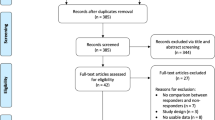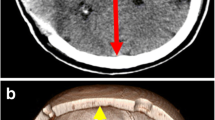Abstract
Background
The aim of this article was to review the clinical practice of “bone flap decompression” in Regional Neurosurgical Units with no particular protocol in use.
Methods
From January 2005 to December 2008, a retrospective and multicentre study was conducted on patients who were treated with decompressive craniectomy (DC) in seven departments of neurosurgery in Italy. This study included patients with traumatic brain injury, stroke, aneurysmal subarachnoid haemorrhage and cerebral arteriovenous malformations. Data were retrieved from individual medical records.
Results
We identified 526 patients with DC. Age was the most significant predictor factor of survival, together with pupil reactivity, time of decompression and size of the bone flap. The effect of age in predicting survival was so important that in patients over 65 years old we did not find any other significant factor related to survival. In younger patients, the survival rate was much better with a large bone flap (p = 0.01). Unfortunately, 57% of patients were decompressed with a bone flap of less than 12 cm in diameter. This was probably due to the association in 80% of cases between haematoma evacuation and decompression.
Conclusions
The current practice in many centres is different from published papers. Decompression is common over the age of 65 years, is associated with haematoma evacuation and often the bone flaps are inadequate in terms of size.


Similar content being viewed by others
References
Aarabi B, Hesdorffer DC, Ahn ES, Aresco C, Scalea TM, Eisenberg HM (2006) Outcome following decompressive craniectomy for malignant swelling due to severe head injury. J Neurosurg 104:469–479
Aarabi B, Hesdorffer DC, Simard JM, Ahn ES, Aresco C, Eisenberg HM, McCunn M, Scalea T (2009) Comparative study of decompressive craniectomy after mass lesion evacuation in severe head injury. Neurosurgery 64:927–939
Albanese J, Leone M, Alliez JR, Kaya JM, Antonini F, Alliez B, Martin C (2003) Decompressive craniectomy for severe traumatic brain injury: evaluation of the effects at one year. Crit Care Med 31:2535–2538
Bentley JN, Figueroa RE, Vender JR (2009) From presentation to follow-up: diagnosis and treatment of cerebral venous thrombosis. Neurosurg Focus 27:E4
Bullock MR, Chesnut R, Ghajar J, Gordon D, Hartl R, Newell DW, Servadei F, Walters BC, Wilberger J (2006) Surgical management of traumatic parenchymal lesions. Neurosurgery 58:S25–46
Compagnone C, Murray GD, Teasdale GM, Maas AI, Esposito D, Princi P, D'Avella D, Servadei F (2005) The management of patients with intradural post-traumatic mass lesions: a multicenter survey of current approaches to surgical management in 729 patients coordinated by the European Brain Injury Consortium. Neurosurgery 57:1183–1192
Cooper DJ, Rosenfeld JV, Murray L, Arabi YM, Davies AR, D'Urso P, Kossmann T, Ponsford J, Seppelt I, Reilly P, Wolfe R (2011) Decompressive craniectomy in diffuse traumatic brain injury. N Engl J Med 364:1493–1502
Cooper PR, Rovit RL, Ransohoff J (1976) Hemicraniectomy in the treatment of acute subdural hematoma: a re-appraisal. Surg Neurol 5:25–28
De Bonis P, Pompucci A, Mangiola A, D'Alessandris QG, Rigante L, Anile C (2010) Decompressive craniectomy for the treatment of traumatic brain injury: does an age limit exist? J Neurosurg 112:1150–1153
De Bonis P, Pompucci A, Mangiola A, Paternoster G, Festa R, Nucci CG, Maviglia R, Antonelli M, Anile C (2011) Decompressive craniectomy for elderly patients with traumatic brain injury: it's probably not worth the while. J Neurotrauma 28:2043–2048
Di Rienzo A, Iacoangeli M, Rychlicki F, Veccia S, Scerrati M (2008) Decompressive craniectomy for medically refractory intracranial hypertension due to meningoencephalitis: report of three patients. Acta Neurochir (Wien) 150:1057–1065
Escudero Augusto D, Marques Alvarez L, Taboada Costa F (2008) Up-date in spontaneous cerebral hemorrhage. Med Intensiva 32:282–295
Guresir E, Schuss P, Vatter H, Raabe A, Seifert V, Beck J (2009) Decompressive craniectomy in subarachnoid hemorrhage. Neurosurg Focus 26:E4
Hukkelhoven CW, Steyerberg EW, Rampen AJ, Farace E, Habbema JD, Marshall LF, Murray GD, Maas AI (2003) Patient age and outcome following severe traumatic brain injury: an analysis of 5600 patients. J Neurosurg 99:666–673
Jennett B, Bond M (1975) Assessment of outcome after severe brain damage. Lancet 1:480–484
Jiang JY, Xu W, Li WP, Xu WH, Zhang J, Bao YH, Ying YH, Luo QZ (2005) Efficacy of standard trauma craniectomy for refractory intracranial hypertension with severe traumatic brain injury: a multicenter, prospective, randomized controlled study. J Neurotrauma 22:623–628
Kocher T (1901) Die Therapie des Hirndruckes. In: Hölder A (ed) Hirnerschütterung. Hirndruck und chirurgische Eingriffe bei Hirnkrankheiten, Vienna, pp 262–6
Li LM, Timofeev I, Czosnyka M, Hutchinson PJ (2010) Review article: the surgical approach to the management of increased intracranial pressure after traumatic brain injury. Anesth Analg 111:736–748
Mitchell P, Gregson BA, Vindlacheruvu RR, Mendelow AD (2007) Surgical options in ICH including decompressive craniectomy. J Neurol Sci 261:89–98
Munch E, Horn P, Schurer L, Piepgras A, Paul T, Schmiedek P (2000) Management of severe traumatic brain injury by decompressive craniectomy. Neurosurgery 47:315–322
Polin RS, Shaffrey ME, Bogaev CA, Tisdale N, Germanson T, Bocchicchio B, Jane JA (1997) Decompressive bifrontal craniectomy in the treatment of severe refractory posttraumatic cerebral edema. Neurosurgery 41:84–92
Ransohoff J, Benjamin V (1971) Hemicraniectomy in the treatment of acute subdural haematoma. J Neurol Neurosurg Psychiatry 34:106
Sahuquillo J, Arikan F (2006) Decompressive craniectomy for the treatment of refractory high intracranial pressure in traumatic brain injury. Cochrane Database Syst Rev. doi:10.1002/14651858.CD003983
Servadei F (2011) Clinical value of decompressive craniectomy. N Engl J Med 364:1558–1559
Taylor A, Butt W, Rosenfeld J, Shann F, Ditchfield M, Lewis E, Klug G, Wallace D, Henning R, Tibballs J (2001) A randomized trial of very early decompressive craniectomy in children with traumatic brain injury and sustained intracranial hypertension. Childs Nerv Syst 17:154–162
The Brain Trauma Foundation, The American Association of Neurological Surgeons (2000) The joint section on neurotrauma and critical care. Intracranial pressure treatment threshold. J Neurotrauma 17:493–495
Timofeev I, Czosnyka M, Nortje J, Smielewski P, Kirkpatrick P, Gupta A, Hutchinson P (2008) Effect of decompressive craniectomy on intracranial pressure and cerebrospinal compensation following traumatic brain injury. J Neurosurg 108:66–73
Vahedi K, Hofmeijer J, Juettler E, Vicaut E, George B, Algra A, Amelink GJ, Schmiedeck P, Schwab S, Rothwell PM, Bousser MG, van der Worp HB, Hacke W (2007) Early decompressive surgery in malignant infarction of the middle cerebral artery: a pooled analysis of three randomised controlled trials. Lancet Neurol 6:215–222
Wendell LC, Khan A, Raser J, Lang SS, Malhotra N, Kofke WA, LeRoux P, Park S, Levine JM (2010) Successful management of refractory intracranial hypertension from acute hyperammonemic encephalopathy in a woman with ornithine transcarbamylase deficiency. Neurocrit Care 13:113–117
Williams RF, Magnotti LJ, Croce MA, Hargraves BB, Fischer PE, Schroeppel TJ, Zarzaur BL, Muhlbauer M, Timmons SD, Fabian TC (2009) Impact of decompressive craniectomy on functional outcome after severe traumatic brain injury. J Trauma 66:1570–1574
Wirtz CR, Steiner T, Aschoff A, Schwab S, Schnippering H, Steiner HH, Hacke W, Kunze S (1997) Hemicraniectomy with dural augmentation in medically uncontrollable hemispheric infarction. Neurosurg Focus 2:E3
Acknowledgments
The authors wish to thank the following doctors who contributed to patient care and inclusion in the study:
Azienda Ospedaliero Universitaria Parma: Drs. Marsilio Saccavini, Rodolfo Brianti, Mario Mergoni and Eugenio Benericetti; and Prof. Guido Fanelli. Azienda Santa Maria Nuova Reggio Emilia: Drs. Walter Bottari, Giovanni Battista Camurri and Reza Ghadirpour. Azienda Sanitaria Locale di Modena: Drs. Pietro Pinna, Marco Franceschini and Raffaele Stacca. Azienda Ospedaliero Universitaria di Ferrara: Drs. Roberto Padovani and Aurelia Guberti. Azienda Sanitaria Locale di Bologna: Drs. Giovanni Gordini, Marco Zanello and Alvaro Andreoli; Prof. Fabio Calbucci and Dr. Roberto Piperno. Azienda Sanitaria Locale di Cesena: Drs. Luigi Targa, Arturo Chieregato, Roberto Battaglia, Gilberto Vergoni and Andrea Naldi. Dr. Christian Compagnone is thanked for his kind help with statistical data evaluation.
Conflicts of interest
None.
Author information
Authors and Affiliations
Corresponding author
Rights and permissions
About this article
Cite this article
Tagliaferri, F., Zani, G., Iaccarino, C. et al. Decompressive craniectomies, facts and fiction: a retrospective analysis of 526 cases. Acta Neurochir 154, 919–926 (2012). https://doi.org/10.1007/s00701-012-1318-0
Received:
Accepted:
Published:
Issue Date:
DOI: https://doi.org/10.1007/s00701-012-1318-0




